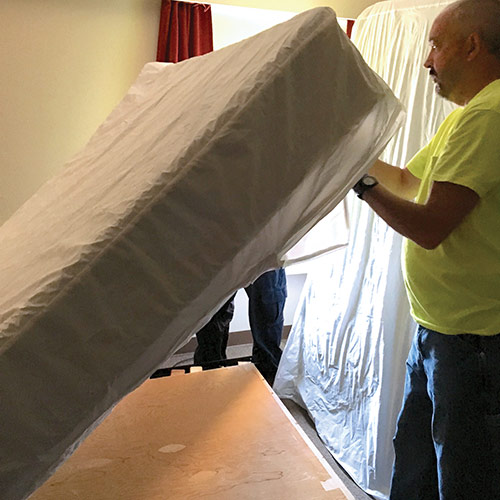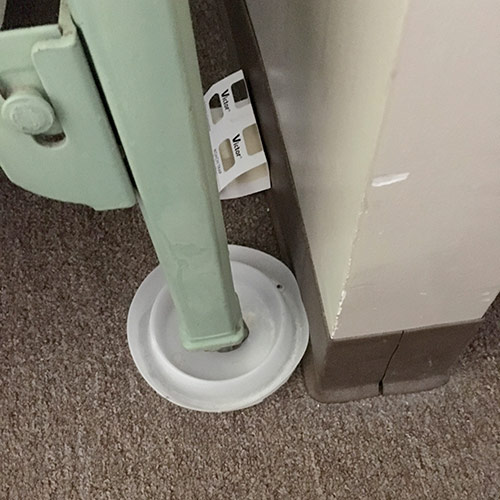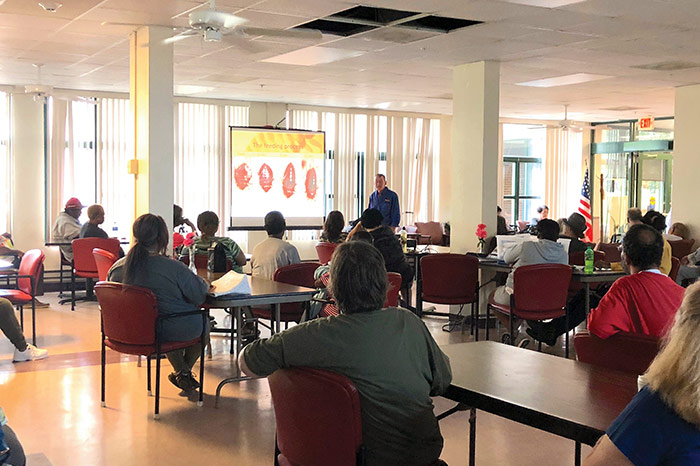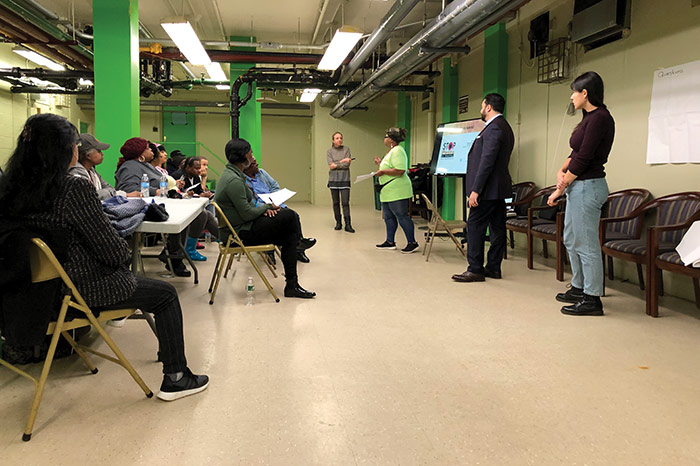Study: Improving Pest Management in Multifamily Housing
 |
|
A technician installs a bed bug cover on a mattress. Photo: StopPests in Housing Program |
By Susannah Krysko, MS, StopPests in Housing Program Manager
The COVID-19 pandemic and ensuing efforts to recover have brought unique challenges to society, with some ramifications yet to be fully realized.
Pandemic-related interruptions in services included a reduction or cessation of pest-management inspections and treatments in multifamily housing, creating an opportunity for pest activity and infestations to grow. Pest resurgence in low-income housing—particularly those properties managed by public housing agencies (PHAs)—are of particular concern.
Now that services are resuming, building managers and pest-control professionals are left catching up and, in some cases, struggling to get pests under control in multifamily housing.
Even prior to COVID, there were relatively low expectations for pest-management success in PHAs. That, combined with pandemic-induced interruptions, have resulted in lasting implications in low-income and public housing.
Challenge Begets Opportunity
Pandemic-related interruptions included a reduction or cessation of pest-management inspections and treatments in multifamily housing, creating an opportunity for pest activity and infestations to grow.
Stephen Kells, PhD, an entomologist at the University of Minnesota, recognized the opportunity to rethink pest control and develop a new system of approaching pest management for multifamily housing.
Kells received a subaward through the StopPests in Housing Program, which is administered by the Northeastern Integrated Pest Management (IPM) Center through a contract with the Office of Lead Hazard Control and Healthy Homes at the Department of Housing and Urban Development (HUD).
Kells uses data analysis to map out a pest-control plan that allows for constant assessment and improvement of pest-control practices.
 |
|
Sticky traps and bed bug interceptors can help assess pest control efforts. Photo: S. Krysko |
How Traditional Approaches Come Up Short
Without periodic assessments, it’s easy to remain complacent with the status quo, where there’s no expectation of progress in reducing overall pest populations. Traditionally, pest-control efforts in multifamily housing have followed a typical cycle:
- Complaint from a single unit within a building
- Response with various treatment options on that unit
- Wait until next complaint or detection
- Additional responses
This cycle becomes an infinite loop because crucial steps are often missing:
- Evaluating the whole building, not just individual affected units
- Designing a control strategy based on knowledge of pest biology and habitats in the structure
- Using pre- and post-treatment assessment of pest activity to refine control procedures
- Scheduling critical preventative actions
- Ensuring effective communication between facility managers and residents
- Monitoring costs for budgetary efficiencies
Because of these omissions, there is ongoing frustration experienced by residents, staff, and management alike, as well as substantial costs from pest-management practices that fail to stop chronic problems.
Breaking the Cycle: Using Data to Guide Decisions
Without periodic assessments, it’s easy to remain complacent with the status quo, where there’s no expectation of progress in reducing overall pest populations.
To find an efficient solution that could be adopted by other agencies, Kells analyzed pest-management data across 42 high-rises and developments of the Minneapolis Public Housing Authority (MPHA, representing some 5,500 apartments) to make decisions about resource allocation.
The goal of this study was to learn how to provide consistency of service and early detection, and to use data to prioritize, plan, and test with pilot programs. The University of Minnesota provided data analysis, staff training, in-field observations, monitor setup, annual assessments, and monthly discussions with in-house pest-management staff and managers from the MPHA.
Study Findings
 |
|
Resident education programs are aimed at increasing residents’ awareness of pests and signs of their presence. Photo: StopPests in Housing Program |
Communication and Thoroughness
The first finding was the need for improvement in communication and expectations for a successful pest-management program throughout the organization.
Communication must be across all levels of the organization, from the pest-management technicians all the way up to the chief operating officer, executive director, or upper-level management. To improve IPM practices, an organization should first look at their system of communication at all levels and ensure feedback from the technicians is incorporated.
MPHA data going back to 2009 was analyzed and revealed that 67 to 82 percent of the pest-control work orders were from 11 to 16 percent of the apartments, meaning that the majority of resources were going to a relatively small number of apartments with chronic infestations and repeat pest services. (Chronic infestations were defined as those that needed more than two treatments annually.)
Once they determined that the pest-control treatments in these chronic apartments were not sufficiently thorough, they looked at how time and attention could be increased in those units for more effective control. If time and resources were spent upfront, fewer repeat visits were needed.
They first communicated to the technicians that the expectation was delivery of effective control in one service visit. Although follow-up visits are always needed in pest control, it set the expectation that the treatment would be thorough. Technicians, in turn, stated they could do this only if given fewer work orders per day. They also often need extra help and supplies.
This underscores the vital need for effective communication up and down organizational levels.
When technicians think pest infestations are the “residents’ fault,” the level of service declines because they can become frustrated or complacent. Sanitation helps, but it is not imperative; nonetheless, it is often used as an excuse for not achieving pest elimination. As such, technicians were expected to provide thorough service and eliminate infestations regardless of cooperation by residents.
Once the work-order service times were increased, more thorough control was achieved, and less time was needed for repeat infestation treatments. Eventually, more time was devoted to other IPM measures, including preventative treatments like exclusion and inspections.
Infestations Don’t Occur in Isolation
The study found inspections can be streamlined if infestations are mapped across a building.
Mice, cockroaches, and bed bugs are often found aggregated in apartment clusters. If inspections occur only in the apartments of residents reporting pests, technicians will miss likely infestations in neighboring units.
Developing adjacent-apartment inspection protocols is vital for all pests, not just bed bugs. The work-order system must trigger automatic adjacent apartment inspections and additional control measures.
The study also used work-order data to prioritize resource allocation to the buildings with higher-level and more-frequent infestations. When prioritizing work across a PHA, it can be helpful to use data to prioritize buildings based on pest complaints per number of apartments.
Customizing Work Orders to the Task at Hand
Including additional work-order types allows the housing authority to track pest treatments separately from preventative measures, which demonstrates how preventative work decreases the need for active treatment.
Another finding that demonstrated the importance of communication is that offering a wider variety of work-order types can both increase and track the thoroughness of treatments.
When work orders collect only general information (i.e., “pest-control treatment”), we don’t know all that has been done and whether IPM methods—including preventative treatments like exclusion—have been used. Using an expanded work-order list can help prioritize additional actions that are sometimes overlooked or that there is no time to complete. And if services are not documented in a work order, they probably are not being completed.
Of particular importance for IPM, including an expanded list of tasks allows time and resources to be devoted to preventative measures, not simply reactive ones. If there is a work order to apply exclusion measures (e.g., installing door sweeps, filling holes), you know this task was completed rather than assuming it was tacked onto a pest-control treatment.
The MPHA expanded their system to include an additional 17 work-order types for treatments and prevention. This allows the housing site to analyze what has been done and what has proven effective. It also allows the MPHA to track actual pest treatments separately from preventative measures, which demonstrates how preventative work helps decrease the need for active treatment.
 |
|
Resident education programs are aimed at increasing residents’ awareness of pests and signs of their presence. Photo: StopPests in Housing Program |
Resident Outreach
Unreported or unknown infestations can be a population reservoir that keeps a steady supply of pests in a building and circulating around. Measures like offering education programs or meeting with residents are aimed at increasing residents’ awareness of pests and signs of their presence, and seek to encourage reporting of pests.
When residents request an inspection or treatment, it allows pest-control technicians into more homes and enables them to gain better control building-wide.
There is a caveat: analysis of MPHA data showed a spike in complaints around the time the resident education program was provided. More residents were inclined to report pests or request an inspection after the education program, but this impact was temporary, and complaints went back down shortly thereafter. This suggests resident education is effective but needs to be repeated on a regular basis.
Study Conclusions
Through the analysis of the MPHA data, the study offers four main conclusions for improving pest-control success across an organization:
- Standardize expectations for pest-control technicians to provide thorough service. Communicate and allow for technicians to spend more time in chronic apartments with fewer work orders per day. Break out work orders into detailed treatment and prevention subtypes so the organization can measure a drop in pest treatments when prevention jobs like exclusion are done.
- Develop adjacent-apartment inspections protocols for all pests.
- Use pest complaints to prioritize more infested buildings and allocate resources and time to doing an effective job.
- Resident education works, but it has to be regularly repeated.
For More Information
To watch Kells present his findings, watch the recorded webinar: stoppests.org/go/3steps
The Northeastern IPM Center promotes integrated pest management for reducing risks to human health and the environment. If republishing our news, please acknowledge the source (“From Northeast IPM Insights”) along with a link to our website.
